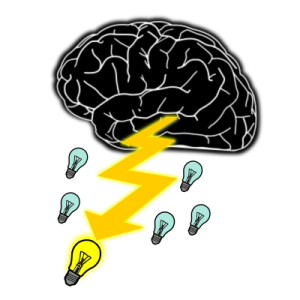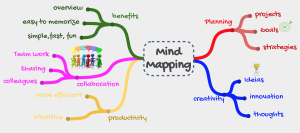Prewriting 2: Generating Ideas
 In general, it’s best to understand your task first and then start digging in to the assignment and your topic. Once you understand your writing task, you’ll be ready to start working on your ideas and your sources.
In general, it’s best to understand your task first and then start digging in to the assignment and your topic. Once you understand your writing task, you’ll be ready to start working on your ideas and your sources.
Keep in mind that the process and strategies described in this section are not intended to be overly sequential or rigid. Sometimes, you may find that you get new ideas for your paper as you read a source. There is nothing that says that you can’t work on developing those ideas while reading and annotating your sources. Other times, you may find that you have a new idea to add to your paper while you’re revising. Don’t let an overly rigid view of the process keep you from jumping to whatever stage is most productive for you.
Also, while you are prewriting especially, tell your inner critic to shut up and go take a nap. You need to be producing ideas, not shutting them down, even if some of them won’t work. If you censor yourself too much, you can talk yourself out of any possible topic and get stuck.
Starting When You Don’t Have a Topic…Yet
Sometimes the ideas for a paper come to us quickly. We know what we want to write about, or our problem may be too many ideas, rather than not enough. If that’s the case, you can skip this section (at least for this project), but you’ll want to pick up again when we get to narrowing your focus.
You may feel anxious if you don’t yet have a topic, and that anxiety may encourage you to latch onto the first topic that seems vaguely connected to the assignment, even if you don’t think it will work. Resist that urge. Finding a workable topic doesn’t take much time, and trying to work with a topic that isn’t viable or that you hate will ultimately cost you much more time.
So, first, take a breath. Ideas for topics are all around you. You just need to try some strategies to bring out the ones that can work for you.
View the instructions.
If you are stuck for a topic, in 15 minutes or so, make quick notes on the following questions, without worrying about how these notes connect to the assignment (yet):
- Your major: What do you find interesting about your major (or a major you are considering)? What makes you want to pursue that field of study?
- Class topics: What intriguing topics have come up in this class or in other classes? What are you curious about?
- Popular topics: What ideas or issues are people talking about on social media, on the internet, or in popular magazines/newspapers that you would like to know more about?
- Your own knowledge: What are you already familiar with and know well? What do you spend your time on?
- Your passions: What do you care deeply about? What makes you angry or upset? What makes you excited or happy?
- Your experiences: What has happened to you that warrants further exploration?
It’s very important not to censor yourself as you write your notes. Don’t cross out a topic while you are generating ideas.
Now make a short list. Circle or highlight the topics that are the most likely to work for this assignment. If you have more than one, don’t worry. You’ll be able to try out the techniques in the next section on more than one topic, which should help you focus in on what you want to write about.
It’s also worth doing a quick internet search to get a sense of whether there is information available on your topic. While you won’t necessarily use those sources, this search can give you a sense of whether the topic has been hashed over thoroughly and whether it’s a recent topic. That search might also give you some additional ideas.
Narrowing or Focusing Your Topic
When writers choose their own topics, they frequently begin with broad topics: stem cell research, child abuse, or climate change, for example. These are all potentially fine topics, but they are far too broad to be covered effectively in most college-level writing assignments. While you can begin with a broad topic, you need to narrow your topic down (also called “focusing”) before you’ll be able to produce a successful essay or other project.
To narrow your topic, you need to find ways to look at your topic from specific angles or through specific lenses. Let’s take, for example, remote learning:
| Narrowing Method | Example of a Narrowed Approach |
| A specific time span or era | Remote learning effects during the COVID-19 pandemic |
| A specific location | Remote learning options and limitations for students in rural areas |
| The perspective of a specific discipline or subject area | Effectiveness of remote lab exercises for introductory biology |
| A specific problem, solution, or question | Whether high school students suffer “learning loss” in remote learning situations |
| A specific subdivision or category within the topic | Effective uses of Zoom classrooms for remote learning |
| Points to argue for or against | The need for continued remote learning options, particularly for neurodivergent populations |
| Points of comparison or contrast | Benefits of synchronous online classrooms vs. asynchronous courses for remote learning |
| Cause and effect | Relationship between remote courses and college retention and persistence |
Don’t lock yourself into a narrowed topic too soon. Sometimes, you will figure out the best way to focus your topic along the way, particularly if you are required to use sources. If you start finding too much information, consider narrowing your topic even further. If you are not finding enough information, look for ways to broaden your topic in the research you have done thus far.
If you have a broad topic, try using the chart above. Try to find at least one narrowed version of your topic using each method.
Then, highlight, circle, or otherwise mark the topics that you think will work best, given the parameters of the assignment. Length will be important here, but so will sources.
For each topic you think is workable, try doing a quick internet search to see if there are relevant discussions and to see if you get any more ideas for narrowing.
If you aren’t sure whether a topic will work, see your professor!
Starting to Write
It’s never too early to start writing down your ideas. At this phase, you aren’t worried about how strong the ideas are or whether there is research to back them up—or even whether your ideas are good ones. Instead, you are just getting ideas down so that you can more easily examine them.
You are probably already familiar with at least some of the techniques I describe in this section.
Brainstorming
Write out in a list all of the ideas you have while thinking about your topic. Use the assignment as a guide. If you are supposed to examine the pros and cons of an issue, try to keep your attention on whether something is positive or negative. If you are supposed to explain the reasons that people have for holding a particular position, try to keep your list focused on reasons. But don’t worry if you stray. You can always ignore that idea later.
By the way, brainstorming can also be used to choose a topic in the first place.
Mind mapping
 Also called bubbling or clustering, this technique has you write your topic in the center of a page and draw a circle around it. Then, you start adding ideas to the page, drawing circles around the topics and subtopics and adding lines to connect ideas to one another. The resulting map can give you ideas for details and organization as well as supporting ideas. There are also apps that can help you do this kind of prewriting.
Also called bubbling or clustering, this technique has you write your topic in the center of a page and draw a circle around it. Then, you start adding ideas to the page, drawing circles around the topics and subtopics and adding lines to connect ideas to one another. The resulting map can give you ideas for details and organization as well as supporting ideas. There are also apps that can help you do this kind of prewriting.
Freewriting
Set a timer for 5 or 10 minutes. Put pen to paper or fingers to keyboard and write. Don’t stop. If you really can’t think of anything, write “I can’t think of anything” until the time is up or you think of something.
Freewriting is like brainstorming, but in more detail. Just let the ideas flow, and definitely don’t worry about grammar and spelling and punctuation. If you write perfect sentences, great! If you write really messy sentences, great! The point is to get the ideas out. If you like the ideas you produce, you can always fix the sentences later.
Remember your inner editor—you know, the one that I told you to tell to shut up? On many word processors, that inner editor has a friend. Squiggles or underlines appear whenever the software thinks we’ve made an error. It’s easy to get distracted by these marks and to feel the need to fix your writing so that they go away.
While you can turn them off, there is a simpler way to shut the editor down: turn your monitor off. If you cannot turn your monitor off because you are working on a laptop, try opening your laptop flat on the table or putting a piece of paper over the screen. If you can’t see the text as it appears, you can’t see the lines either!
This can be disconcerting at first, and you will probably still try to correct your mistakes. But eventually, you’ll settle in and focus on what you want to say, which is the point.
If freewriting works for you, consider adjusting it to meet your needs. For example, if you might find that 5-10 minutes isn’t enough time, try writing for longer periods.
Or try using it in specific situations. For example, I use this technique when I find myself getting stuck trying to write clear explanations. I flip to a new screen and write like I’m explaining the idea to my sisters, who aren’t familiar with my topic. Once I find the flow of the explanation again, I copy the part that works into my draft, and I’m back on track!
Using Sources for Ideas
In the fourth section, I talk in more detail about locating and using sources, but for the purposes of prewriting, I want you to think about how you can use sources to generate ideas.
As you read the sources that you are planning to use for your project, use note-taking and reflection strategies in particular, to make sure you are keeping track of things like the following:
- Passages that might be useful in your project
- Ideas for your paper that you get while reading
- Responses to the ideas that you are reading
- Connections between ideas in different sources
- Contradictions between ideas in different sources
Don’t just mark passages in a reading that you might use. Take notes on how what you think about those passages and how you might use them. You also might find it helpful to copy these passages and notes into a document where you can start drafting.
Key Points: Generating Ideas
- It’s better to understand the assignment, including your purpose and audience, before you start generating ideas.
- If you don’t have a topic, explore ideas from other classes, areas you are interested in, your experiences, and issues that you care about for possible topics.
- If you have a topic but need to narrow it down, try taking a specific angle on your topic. There’s a list of ways to focus your topic in the table in this chapter.
- Try different ways to get started writing about your topic:
- Brainstorming
- Mindmapping
- Freewriting
- Taking notes as you read your sources
Media Attributions
Lightbulbs, Photo by Dstudio Bcn on Unsplash
“Brainstorming Icon” by Jan Helebrant is in the Public Domain.
“Memorize Mind Map” by Fernandosca is licensed under CC BY-SA 4.0. The original work was edited slightly for inclusion in this chapter.
Text Attribution
This chapter was revised with the help of students in my class during Fall 2022 (who wished to remain nameless). I am particularly grateful for the idea to include the “Key Points” section here, which I have added most chapters.
Forming or following in a logical order or sequence.
A technique for generating ideas that involves listing as many as you can think of quickly.

